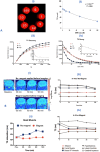Multifunctional Nanotherapeutics for the Treatment of neuroAIDS in Drug Abusers
- PMID: 30154522
- PMCID: PMC6113246
- DOI: 10.1038/s41598-018-31285-w
Multifunctional Nanotherapeutics for the Treatment of neuroAIDS in Drug Abusers
Abstract
HIV and substance abuse plays an important role in infection and disease progression. Further, the presence of persistent viral CNS reservoirs makes the complete eradication difficult. Thus, neutralizing the drug of abuse effect on HIV-1 infectivity and elimination of latently infected cells is a priority. The development of a multi-component [antiretroviral drugs (ARV), latency reactivating agents (LRA) and drug abuse antagonist (AT)] sustained release nanoformulation targeting the CNS can overcome the issues of HIV-1 cure and will help in improving the drug adherence. The novel magneto-liposomal nanoformulation (NF) was developed to load different types of drugs (LRAs, ARVs, and Meth AT) and evaluated for in-vitro and in-vivo BBB transmigration and antiviral efficacy in primary CNS cells. We established the HIV-1 latency model using human astrocyte cells (HA) and optimized the dose of LRA for latency reversal, Meth AT in in-vitro cell culture system. Further, PEGylated magneto-liposomal NF was developed, characterized for size, shape, drug loading and BBB transport in-vitro. Results showed that drug released in a sustained manner up to 10 days and able to reduce the HIV-1 infectivity up to ~40-50% (>200 pg/mL to <100 pg/mL) continuously using single NF treatment ± Meth treatment in-vitro. The magnetic treatment (0.8 T) was able to transport (15.8% ± 5.5%) NF effectively without inducing any toxic effects due to NF presence in the brain. Thus, our approach and result showed a way to eradicate HIV-1 reservoirs from the CNS and possibility to improve the therapeutic adherence to drugs in drug abusing (Meth) population. In conclusion, the developed NF can provide a better approach for the HIV-1 cure and a foundation for future HIV-1 purging strategies from the CNS using nanotechnology platform.
Conflict of interest statement
The authors declare no competing interests.
Figures






Similar articles
-
Novel nanoformulation to mitigate co-effects of drugs of abuse and HIV-1 infection: towards the treatment of NeuroAIDS.J Neurovirol. 2017 Aug;23(4):603-614. doi: 10.1007/s13365-017-0538-8. Epub 2017 Jul 31. J Neurovirol. 2017. PMID: 28762183 Free PMC article.
-
Maraviroc Is Associated with Latent HIV-1 Reactivation through NF-κB Activation in Resting CD4+ T Cells from HIV-Infected Individuals on Suppressive Antiretroviral Therapy.J Virol. 2018 Apr 13;92(9):e01931-17. doi: 10.1128/JVI.01931-17. Print 2018 May 1. J Virol. 2018. PMID: 29444937 Free PMC article.
-
HIV Replication and Latency in a Humanized NSG Mouse Model during Suppressive Oral Combinational Antiretroviral Therapy.J Virol. 2018 Mar 14;92(7):e02118-17. doi: 10.1128/JVI.02118-17. Print 2018 Apr 1. J Virol. 2018. PMID: 29343582 Free PMC article.
-
The role of latency reversal agents in the cure of HIV: A review of current data.Immunol Lett. 2018 Apr;196:135-139. doi: 10.1016/j.imlet.2018.02.004. Epub 2018 Feb 7. Immunol Lett. 2018. PMID: 29427743 Review.
-
The impact of substance abuse on HIV-mediated neuropathogenesis in the current ART era.Brain Res. 2019 Dec 1;1724:146426. doi: 10.1016/j.brainres.2019.146426. Epub 2019 Aug 29. Brain Res. 2019. PMID: 31473221 Free PMC article. Review.
Cited by
-
Magneto-plasmonic nanostars for image-guided and NIR-triggered drug delivery.Sci Rep. 2020 Jun 22;10(1):10115. doi: 10.1038/s41598-020-66706-2. Sci Rep. 2020. PMID: 32572041 Free PMC article.
-
MRI-Guided, Noninvasive Delivery of Magneto-Electric Drug Nanocarriers to the Brain in a Nonhuman Primate.ACS Appl Bio Mater. 2019 Nov 18;2(11):4826-4836. doi: 10.1021/acsabm.9b00592. Epub 2019 Oct 17. ACS Appl Bio Mater. 2019. PMID: 35021482 Free PMC article.
-
Nanomedicine for the SARS-CoV-2: State-of-the-Art and Future Prospects.Int J Nanomedicine. 2021 Jan 22;16:539-560. doi: 10.2147/IJN.S283686. eCollection 2021. Int J Nanomedicine. 2021. PMID: 33519200 Free PMC article. Review.
-
Nanocarriers for effective delivery: modulation of innate immunity for the management of infections and the associated complications.J Nanobiotechnology. 2022 Aug 19;20(1):380. doi: 10.1186/s12951-022-01582-8. J Nanobiotechnology. 2022. PMID: 35986268 Free PMC article. Review.
-
Neuroinflammation, Blood-Brain Barrier, and HIV Reservoirs in the CNS: An In-Depth Exploration of Latency Mechanisms and Emerging Therapeutic Strategies.Viruses. 2025 Apr 16;17(4):572. doi: 10.3390/v17040572. Viruses. 2025. PMID: 40285014 Free PMC article. Review.
References
-
- Nath A, Sacktor N. Influence of highly active antiretroviral therapy on persistence of HIV in the central nervous system. Current opinion in neurology. 2006;19:358–361. doi: 10.1097/01.wco.0000236614.51592.ca. - DOI - PubMed
Publication types
MeSH terms
Substances
Grants and funding
- R01 DA042706/DA/NIDA NIH HHS/United States
- R01DA034547/U.S. Department of Health & Human Services | NIH | National Institute on Drug Abuse (NIDA)/International
- R01DA027049/U.S. Department of Health & Human Services | NIH | National Institute on Drug Abuse (NIDA)/International
- R01DA037838/U.S. Department of Health & Human Services | NIH | National Institute on Drug Abuse (NIDA)/International
- R01 DA037838/DA/NIDA NIH HHS/United States
LinkOut - more resources
Full Text Sources
Other Literature Sources
Medical

